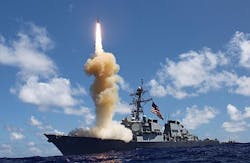Massive October ballistic missile defense test used Mercury's OpenVPX embedded computing
CHELMSFORD, Mass., 25 Nov. 2012. The largest and most complex missile-defense flight test ever attempted, which last month engaged five ballistic and cruise missiles at the same time, used OpenVPX-based radar processing subsystems from Mercury Systems in Chelmsford, Mass.
The U.S. Missile Defense Agency (MDA) Flight Test Integrated-01 (FTI-01) live fire missile defense exercise on 24 Oct. employed the Patriot air and missile defense system and the Aegis ballistic missile defense (BMD) system at the U.S. Army's Kwajalein Atoll/Reagan Test Site in the Pacific Ocean and at Hickam Air Force Base in Hawaii. Mercury's embedded computing subsystems are integrated into the Patriot and Aegis systems.
An integrated air and ballistic missile defense architecture used several sensors and missile defense systems to engage five targets at the same time.
The Terminal High Altitude Area Defense (THAAD) system intercepted its first medium range ballistic target in history, and Patriot Advanced Capability-3 (PAC-3) near simultaneously destroyed a short range ballistic missile and a low flying cruise missile target over water.
The MDA test involved Army soldiers from the 94th and 32nd Army Air and Missile Defense Command (AAMDC); Navy sailors aboard the guided missile destroyer USS Fitzgerald (DDG 62); and airmen from the 613th Air and Space Operations Center.
"Mercury's subsystems are an integral part of the core technology that enables the sophisticated, reliable performance of both the Patriot and Aegis systems," says Didier Thibaud, president of Mercury's Commercial Electronics business group.
Mercury's OpenVPX-based radar processing subsystems are used in Raytheon's Patriot system which detected, tracked and intercepted a short range ballistic missile (SRBM) target during the test. Mercury also provides subsystems and technology integration services to Lockheed Martin for the Aegis system, which tracked a SRBM threat and launched an SM-3 Block 1A interceptor in this exercise.
The live-fire demonstration at the Kwajalein Atoll/Reagan Test Site, Hickam Air Force Base, and surrounding areas in the western Pacific, stressed the performance of the Aegis ballistic missile defense, THAAD, and Patriot weapon systems.
An extended long range air launch target (E-LRALT) missile was air dropped over the broad ocean area north of Wake Island from a U.S. Air Force C-17 aircraft, staged from Joint Base Pearl Harbor-Hickam, Hawaii.
The AN/TPY-2 X-band radar, located with the THAAD system on Meck Island, tracked the E-LRALT and a THAAD interceptor intercepted the medium-range ballistic missile. THAAD was operated by soldiers from the 32nd AAMDC.
Another short-range ballistic missile was launched from a mobile launcher in the ocean northeast of Kwajalein Atoll. The Patriot system, manned by soldiers of the 94th AAMDC, detected, tracked, and intercepted the target with a PAC-3 interceptor.
The USS Fitzgerald engaged a low flying cruise missile over water. The Aegis system also tracked and launched an SM-3 Block 1A interceptor against a Short-Range Ballistic Missile. However, despite indication of a nominal flight of the SM-3 Block 1A interceptor, there was no indication of an intercept of the SRBM.
For more information contact Mercury Systems online at www.mrcy.com.
